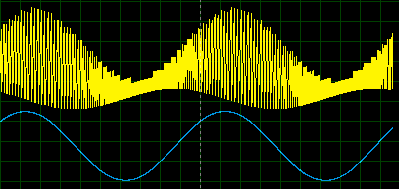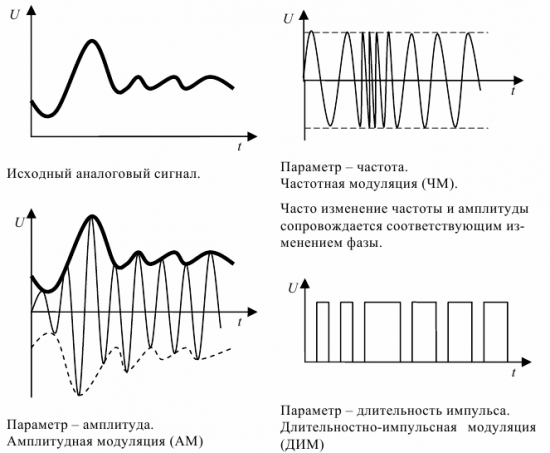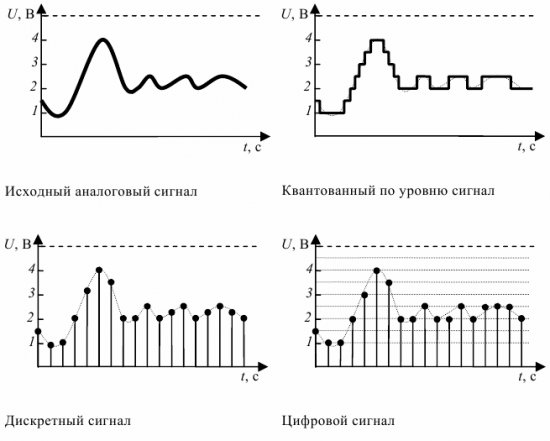Types of signals, modulation
Analog value — a value whose values change continuously in a given interval. Its specific value depends only on the accuracy of the measuring device. This is, for example, the temperature.
A discrete value — a quantity whose values change sharply. For example, the number of students in the classroom. Measurement signal — a signal containing quantitative information about the measured physical quantity. For example, the voltage at the output of a thermoelectric transducer that measures temperature.

Data alert — the form of representation of a data message by a physical quantity, the change of one or several parameters reflecting its change.
In microprocessor technology, signals are electrical quantities (current, voltage). A data signal representative parameter is a data signal parameter whose change reflects a change in the data message (amplitude, frequency, phase, pulse duration, pause duration).
Analog data signal — a data signal in which each of the representing parameters is described by a function of time and a continuous set of possible values, i.e.analog signals are described by a continuous (or piecewise continuous) function xа(t), and the function itself and the argument t can take any values on some intervals

An analog signal f (t) is called periodic if there is a real number T such that f (t + T) = f (t) for every t, and T is called the period of the signal.
Discrete data signal — differs from analogs in that its values are known only at discrete times. Discrete signals are described by lattice functions — sequences — xd (nT), where T = const is the sampling interval (period), n = 0, 1, 2,….
The function xd (nT) itself can take arbitrary values at discrete moments in a certain interval. These function values are called function samples or samples. Another notation for the lattice function x(nT) is x(n) or xn. The sequence x(n) can be finite or infinite, depending on the interval of definition of the function.
Quantized data signal — differs from analog or discrete by dividing the range of values of a continuous or discrete value into a finite number of intervals. The simplest form of quantization is the division of an integer by a natural number, called the quantization factor.
Digital data signal — a signal in which each of the representing parameters is described by a discrete time function and a finite set of possible values. Digital signals are described by quantized lattice functions x° C(nT). When a digital signal is obtained from an analog signal, sampling and quantization occurs.
Binary digital signal — a data signal that uses a method of representing information about the value of a parameter in the form of a multi-bit combination of two values - zero and one - and is usually called a binary code.
In binary code, only two digits are used: 1 and 0. Each number contains a number of digits, each of which can contain only one of these digits. One number corresponds to one state of an element, for example a closed contact, and the other to another state of an element - an open contact.
In the binary system, the unit of each bit is twice the neighboring bit of lower order. For integers, the unit of the first (least significant) bit is 20=1, the unit of the second digit is 2 • 20=21 = 2, third — 2 • 21=22= 4, fourth 2 • 22=23= 8, etc. For example, decimal number 214 214 = 2 • 102+1•101+0•25+4•100, and in the binary system 214 = 1 • 27+1•26+0•25+1•24+0•23+1• 22+1•21+0•20 and will be written as 11010110.
Modulation - the process of changing one or more parameters of a high-frequency carrier oscillation according to the law of a low-frequency information signal (message).
Nowadays, binary digital signals are used in digital electronic devices because of the simplicity of encoding and processing. Various types of modulation are used to transmit a digital signal over communication channels (for example, electrical or radio channels).
Let's consider examples of representing parameters of data signals using the example of different types of modulation (see Fig. 1). In addition to the considered types of modulation, there are also phase (PM), time pulse (VIM), pulse width (PWM) and other modulations.
Rice. 1. Different types of signal modulation — different representing parameters of data signals
To understand the essence of a digital signal, consider the following classification. In digital technology, signals are distinguished (Fig. 2):
-
arbitrary in size and continuous in time (analog);
-
random in size and discrete in time (discrete);
-
quantized in size and continuous in time (quantized);
-
quantized in magnitude and discrete in time (digital).
Rice. 2. Analog, discrete, quantized and digital signals
Analog signals are often used to represent continuously changing physical quantities. For example, an analog electrical signal captured by from a thermocouple, carries information about temperature changes, a signal from a microphone — about rapid pressure changes in a sound wave, etc.
In digital and pulse technology, the terminology is not well established. So, a discrete signal is a signal whose representative parameter values are known only at certain moments in time, and it is also a signal, unlike the analog, whose representative parameter can take only fixed values (usually two: logical "zero" or logical "unit").
In the second case, it would be correct to call the signal quantized, but industrial modules are called "discrete signal input modules". In addition to using different physical quantities to convey information, signals also differ in their representational parameters.


